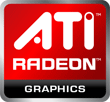ATI Radeon HD 5770 and 5750 Mainstream DX11 GPUs
The Radeon HD 5750 and 5770
Although the Radeon HD 5770 and Radeon HD 5750 are powered by the same GPU, there are some notable differences between the two cards that we should point out. As you can see in the chart above, the Radeon HD 5770 and 5750 sport the same 1.04B transistor GPU, manufactured using TSMC's 40nm process. The lower-end Radeon HD 5750, however, has a lower stock engine clock than the 5770 (700MHz vs. 850MHz) and 80 fewer stream processors (720 vs. 800). The 5750 also has four fewer texture units and a lower stock memory clock, which results in a lower texture fillrate and less peak memory bandwidth. Despite being comprised of over a billion transistors though, the Radeon HD 5700 series GPU is relatively small. The picture above shows a dime next to the GPU as it appears on the Radeon HD 5750, sans cooler. Actual die size is 166mm2 for those keeping score.

Due to its pared down design, the Radeon HD 5750 also has lower power ratings. Idle power for the Radeon HD 5750 and 5770 are an impressive 16W and 18W, respectively, with maximum board power ratings of 86W and 108W. All things considered, the specifications for the Radeon HD 5770 and 5750 very much resemble last year's Radeon HD 4870 and 4850, but with DX11 support and few other new bells and whistles.
Which brings us to the cards. From the front, the Radeon HD 5770 looks very much like the Radeon HD 5870 and 5850 cards that launched over the last few weeks, although the 5770 has a shorter PCB. Cards are equipped with a black fan shroud, with a red stripe running down the middle, that encases the entire front side of the card. The cooler has a barrel fan that draws air into the shroud, where it is forced through the heatsink and partially exhausted from the system through vents in the card's mounting plate. Two more vents at the back of the card also direct some air within the system.
The outputs on the Radeon HD 5770 consist of dual, dual-link DVI outputs, an HDMI output (with audio) and a DisplayPort output. Any combination of three of these ports can be used, and of course the card fully supports the ATI Eyefinity multi-display technology, with up to three displays.
The backside of the Radeon HD 5770 is exposed, but other than the myriad of surface mounted components there isn't much to see. The GPU heatsink retention bracket is visible right about in the center the PCB, with the card's dual CrossFire edge connectors a couple of inches away at the top corner.
As we've mentioned, total board power is rated at 108 watts. As such, the Radeon HD 5770 requires only a single 6-pin PCI Express power connector. Stock frequencies are listed in the chart above, along with peak fillrate and memory bandwidth, and cards are outfitted with 1GB of GDDR5 memory.
The Radeon HD 5750 has an even simpler design than the 5770. The PCB on the card is even shorter than the 5770's and a simple, round heatsink / fan combo sits atop the GPU. The rest of the board, including the back side and VRM, is exposed. The 5750 has the same output configuration as its big brother, with come with either 1GB or 512MB of GDDR5 memory, and it too requires only a single 6-pin PCI Express supplemental power connector.
ATI Radeon HD 5750 Reference Card






